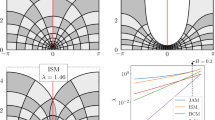Abstract
In many simulations of physical phenomena, discontinuous material coefficients and singular forces pose severe challenges for the numerical methods. The singularity of the problem can be reduced by using a numerical method based on a weak form of the equations. Such a method, combined with an interface tracking method to track the interfaces to which the discontinuities and singularities are confined, will require numerical quadrature with singular or discontinuous integrands. We introduce a class of numerical integration methods based on a regularization of the integrand. The methods can be of arbitrary high order of accuracy. Moment and regularity conditions control the overall accuracy.
Similar content being viewed by others
REFERENCES
J. Beale and A. Majda, Vortex methods. II: Higher order accuracy in two and three dimensions, Math. Comp., 39 (1982), pp. 29-52.
G. Beylkin, On the Fast Fourier Transform of functions with singularities, Appl. Comput. Harmon. Anal., 2 (1995), pp. 363-381.
D. Jackson, The Theory of Approximation, American Mathematical Society, New York, 1930.
B. Merriman, Particle approximation, in Proceedings on Vortex Dynamics and Vortex Methods, AMS Lectures in Applied Mathematics, Vol. 28, 1991, pp. 481-546.
C. S. Peskin, Numerical analysis of blood flow in the heart, J. Comput. Phys., 25 (1977), pp. 220-252.
J. A. Sethian, Level Set Methods and Fast Marching Methods: Evolving Interfaces in Computational Geometry, Fluid Mechanics, Computer Vision and Materials Science, Cambridge University Press, Cambridge, 1999.
J. Strain, 2D vortex methods and singular quadrature rules, J. Comput. Phys., 124 (1996), pp. 131-145.
G. Strang and G. J. Fix, An Analysis of the Finite Element Method, Prentice-Hall, Englewood Cliffs, NJ, 1973. Now published by Wellesley-Cambridge Press, Wellesley, Cambridge, MA.
M. Sussman, P. Smereka, and S. Osher, A level set approach for computing solutions to incompressible two-phase flow, J. Comput. Phys., 114 (1994), pp. 146-159.
A.-K. Tornberg, Interface Tracking Methods with Application to Multiphase Flows, PhD thesis, Royal Institute of Technology, Department of Numerical Analysis and Computing Science, 2000. ISBN 91-7170-558-9, TRITA-NA 0010.
A.-K. Tornberg and B. Engquist, A finite element based level set method for multiphase flow applications, Computing and Visualization in Science, 3 (2000), pp. 93-101.
Author information
Authors and Affiliations
Rights and permissions
About this article
Cite this article
Tornberg, AK. Multi-Dimensional Quadrature of Singular and Discontinuous Functions. BIT Numerical Mathematics 42, 644–669 (2002). https://doi.org/10.1023/A:1021988001059
Issue Date:
DOI: https://doi.org/10.1023/A:1021988001059




